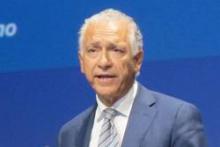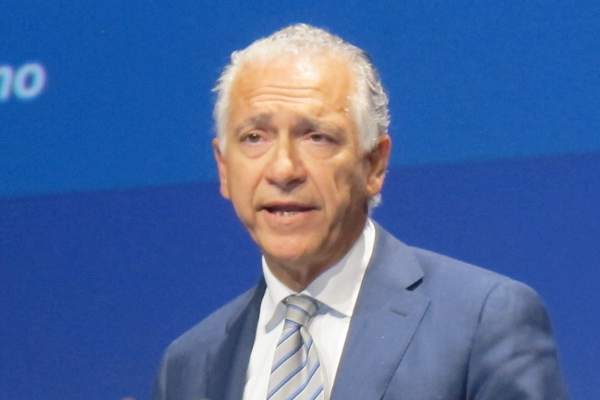User login
DENVER – It’s never too late to quit smoking, results of lung cancer screening trials confirm.
Among more than 3,300 heavy smokers over age 50 who took part in two low-dose CT (LDCT) screening programs, former smokers had a 37% reduction in all-cause mortality, compared with current smokers, and those who were active smokers at the time of randomization but quit during the follow-up period had a 43% lower risk for death, compared with those who continued to smoke, reported Dr. Ugo Pastorino of the Instiuto Nazionale dei Tumori in Milan.
He noted that the U.S. National Lung Screening Trial (NSLT) showed that screening with low-dose helical CT was associated with a nearly 7% reduction in all-cause mortality over 7 years of follow-up, compared with patients screened with chest x-ray.
“But we have to keep clear in our minds that the benefit achieved by this trial of early detection in terms of mortality reduction is only 1% per year, so it’s a not a major improvement. It’s a start, but we have to aim to improve this mortality reduction,” he said at the conference sponsored by the International Association for the Study of Lung Cancer.
Neither the NSLT nor other randomized screening trials currently underway have examined in detail the effects of smoking status on screening outcomes, prompting Dr. Pastorino and colleagues to investigate the matter in two cohorts of smokers assigned to LDCT in screening trials.
The study included 3,381 heavy smokers with a median follow-up of 9.7 years and a total follow-up of 32,858 person-years. Men comprised 69% of the combined cohorts, who had a median age of 58 and a median smoking of 40 pack-years.
The investigators divided the participants into current smokers – those who continued to smoke throughout the screening period, or if they quit did so within 1 year of the end of follow-up or death – and former smokers, subdivided into early quitters, who had stopped smoking by the time of accrual, and late quitters, who were active smokers at the time of accrual or randomization but stopped smoking at least 1 year before the end of the follow-up period or at least 1 year before death.
In an analysis of the effects of smoking on mortality, controlled for gender, age, body mass index, lung function, and pack-years smoked, they found that the relative risk for death from any cause among both early and late quitters, compared with current smokers, was 0.74. When they excluded 239 quitters who had kicked the habit less than 2 years before the end of follow-up or death, the benefits of not smoking were even greater, with an RR of 0.61.
Interestingly, when they looked at the early quitters, compared with current smokers, the RR for quitting was 0.63, and the effect appeared even stronger among more recent (late) quitters, who had a RR for all-cause mortality of 0.57, compared with current smokers. (All comparisons significant as shown by 95% confidence intervals).
Also of note was the fact that lung cancer accounted for fewer than 30% of deaths, Dr. Pastorino noted.
Dr. Nise H. Yamaguchi of the Hospital Israelita Albert Enstein in Sao Paolo, Brazil, applauded Dr. Pastorino and colleagues for the study, and succinctly summarized the take home message.
“If you came here from all around the world to see all these fancy treatments and everything that you can’t do, go back home and help people stop smoking, because you cure lots of people and save many lives for sure,” she said.
DENVER – It’s never too late to quit smoking, results of lung cancer screening trials confirm.
Among more than 3,300 heavy smokers over age 50 who took part in two low-dose CT (LDCT) screening programs, former smokers had a 37% reduction in all-cause mortality, compared with current smokers, and those who were active smokers at the time of randomization but quit during the follow-up period had a 43% lower risk for death, compared with those who continued to smoke, reported Dr. Ugo Pastorino of the Instiuto Nazionale dei Tumori in Milan.
He noted that the U.S. National Lung Screening Trial (NSLT) showed that screening with low-dose helical CT was associated with a nearly 7% reduction in all-cause mortality over 7 years of follow-up, compared with patients screened with chest x-ray.
“But we have to keep clear in our minds that the benefit achieved by this trial of early detection in terms of mortality reduction is only 1% per year, so it’s a not a major improvement. It’s a start, but we have to aim to improve this mortality reduction,” he said at the conference sponsored by the International Association for the Study of Lung Cancer.
Neither the NSLT nor other randomized screening trials currently underway have examined in detail the effects of smoking status on screening outcomes, prompting Dr. Pastorino and colleagues to investigate the matter in two cohorts of smokers assigned to LDCT in screening trials.
The study included 3,381 heavy smokers with a median follow-up of 9.7 years and a total follow-up of 32,858 person-years. Men comprised 69% of the combined cohorts, who had a median age of 58 and a median smoking of 40 pack-years.
The investigators divided the participants into current smokers – those who continued to smoke throughout the screening period, or if they quit did so within 1 year of the end of follow-up or death – and former smokers, subdivided into early quitters, who had stopped smoking by the time of accrual, and late quitters, who were active smokers at the time of accrual or randomization but stopped smoking at least 1 year before the end of the follow-up period or at least 1 year before death.
In an analysis of the effects of smoking on mortality, controlled for gender, age, body mass index, lung function, and pack-years smoked, they found that the relative risk for death from any cause among both early and late quitters, compared with current smokers, was 0.74. When they excluded 239 quitters who had kicked the habit less than 2 years before the end of follow-up or death, the benefits of not smoking were even greater, with an RR of 0.61.
Interestingly, when they looked at the early quitters, compared with current smokers, the RR for quitting was 0.63, and the effect appeared even stronger among more recent (late) quitters, who had a RR for all-cause mortality of 0.57, compared with current smokers. (All comparisons significant as shown by 95% confidence intervals).
Also of note was the fact that lung cancer accounted for fewer than 30% of deaths, Dr. Pastorino noted.
Dr. Nise H. Yamaguchi of the Hospital Israelita Albert Enstein in Sao Paolo, Brazil, applauded Dr. Pastorino and colleagues for the study, and succinctly summarized the take home message.
“If you came here from all around the world to see all these fancy treatments and everything that you can’t do, go back home and help people stop smoking, because you cure lots of people and save many lives for sure,” she said.
DENVER – It’s never too late to quit smoking, results of lung cancer screening trials confirm.
Among more than 3,300 heavy smokers over age 50 who took part in two low-dose CT (LDCT) screening programs, former smokers had a 37% reduction in all-cause mortality, compared with current smokers, and those who were active smokers at the time of randomization but quit during the follow-up period had a 43% lower risk for death, compared with those who continued to smoke, reported Dr. Ugo Pastorino of the Instiuto Nazionale dei Tumori in Milan.
He noted that the U.S. National Lung Screening Trial (NSLT) showed that screening with low-dose helical CT was associated with a nearly 7% reduction in all-cause mortality over 7 years of follow-up, compared with patients screened with chest x-ray.
“But we have to keep clear in our minds that the benefit achieved by this trial of early detection in terms of mortality reduction is only 1% per year, so it’s a not a major improvement. It’s a start, but we have to aim to improve this mortality reduction,” he said at the conference sponsored by the International Association for the Study of Lung Cancer.
Neither the NSLT nor other randomized screening trials currently underway have examined in detail the effects of smoking status on screening outcomes, prompting Dr. Pastorino and colleagues to investigate the matter in two cohorts of smokers assigned to LDCT in screening trials.
The study included 3,381 heavy smokers with a median follow-up of 9.7 years and a total follow-up of 32,858 person-years. Men comprised 69% of the combined cohorts, who had a median age of 58 and a median smoking of 40 pack-years.
The investigators divided the participants into current smokers – those who continued to smoke throughout the screening period, or if they quit did so within 1 year of the end of follow-up or death – and former smokers, subdivided into early quitters, who had stopped smoking by the time of accrual, and late quitters, who were active smokers at the time of accrual or randomization but stopped smoking at least 1 year before the end of the follow-up period or at least 1 year before death.
In an analysis of the effects of smoking on mortality, controlled for gender, age, body mass index, lung function, and pack-years smoked, they found that the relative risk for death from any cause among both early and late quitters, compared with current smokers, was 0.74. When they excluded 239 quitters who had kicked the habit less than 2 years before the end of follow-up or death, the benefits of not smoking were even greater, with an RR of 0.61.
Interestingly, when they looked at the early quitters, compared with current smokers, the RR for quitting was 0.63, and the effect appeared even stronger among more recent (late) quitters, who had a RR for all-cause mortality of 0.57, compared with current smokers. (All comparisons significant as shown by 95% confidence intervals).
Also of note was the fact that lung cancer accounted for fewer than 30% of deaths, Dr. Pastorino noted.
Dr. Nise H. Yamaguchi of the Hospital Israelita Albert Enstein in Sao Paolo, Brazil, applauded Dr. Pastorino and colleagues for the study, and succinctly summarized the take home message.
“If you came here from all around the world to see all these fancy treatments and everything that you can’t do, go back home and help people stop smoking, because you cure lots of people and save many lives for sure,” she said.
AT THE IASLC WORLD CONFERENCE
Key clinical point: Quitting smoking results in a significant reduction in all-cause mortality among heavy smokers taking part in screening programs.
Major finding: Compared with current smokers, the relative risk for all-cause mortality among ex-smokers or recent quitters was 0.74
Data source: Data on two cohorts totaling 3,381 current or ex-smokers assigned to low-dose CT lung screening.
Disclosures: The study was supported by the Italian Ministry of Health.


